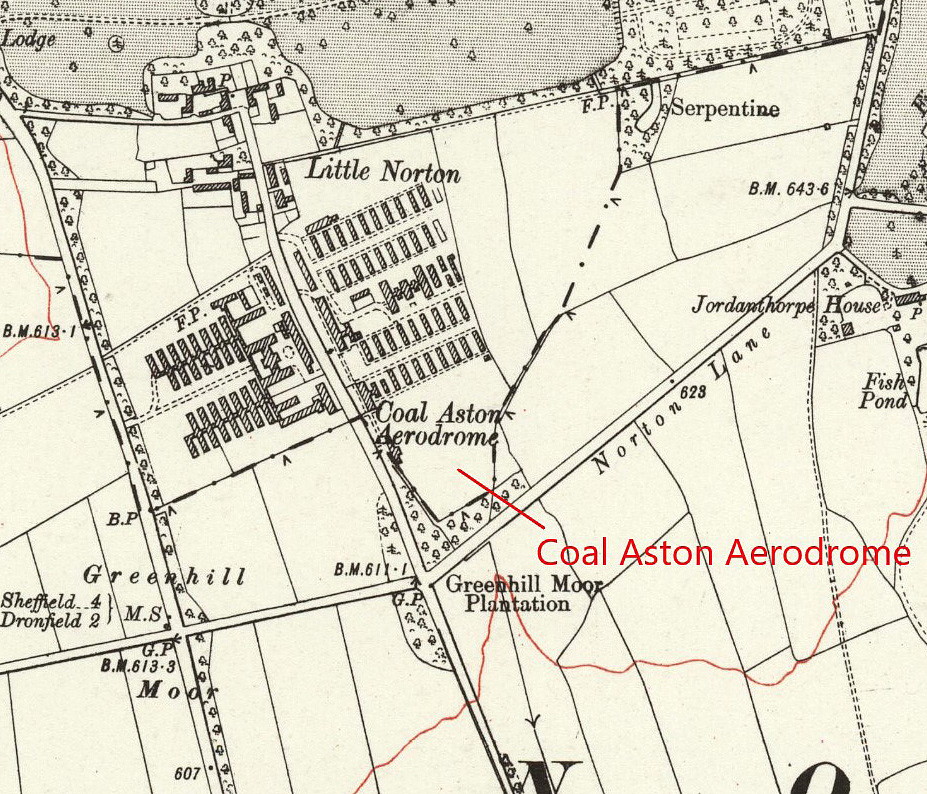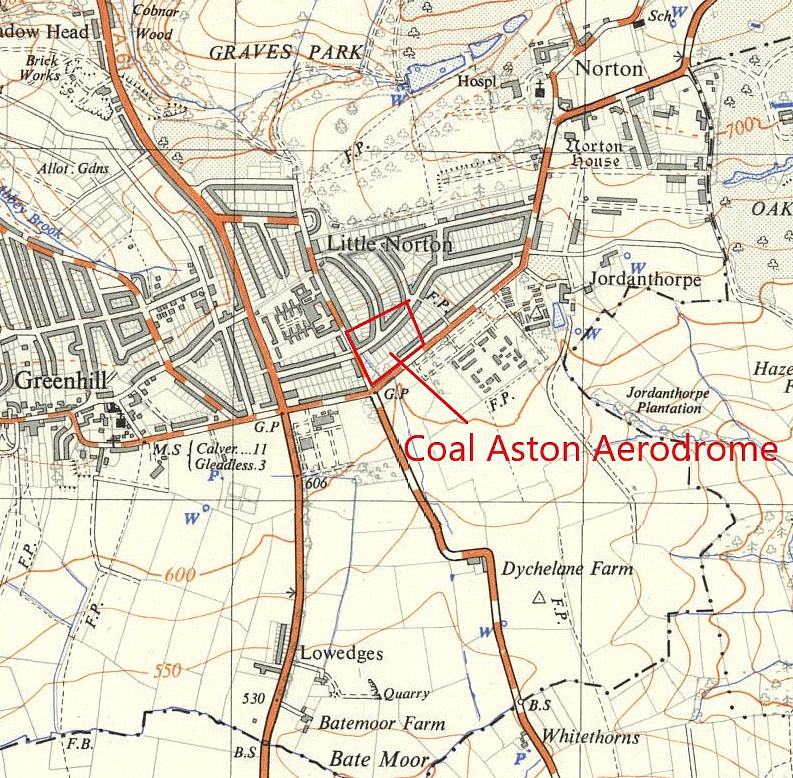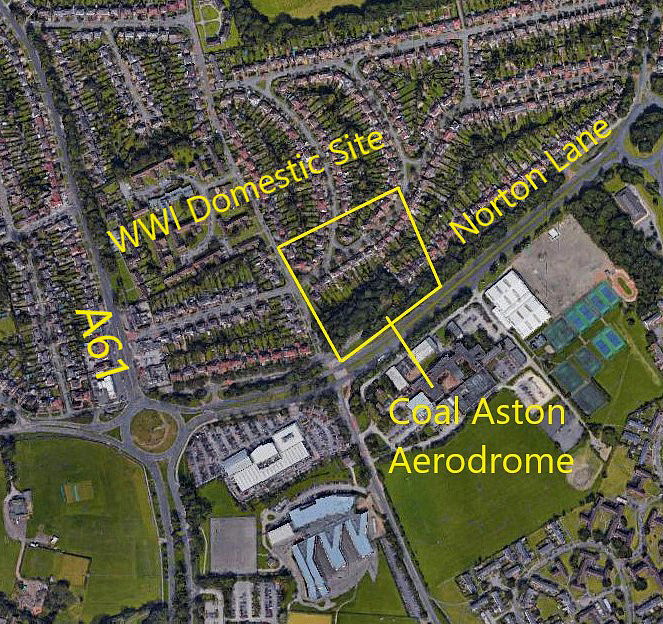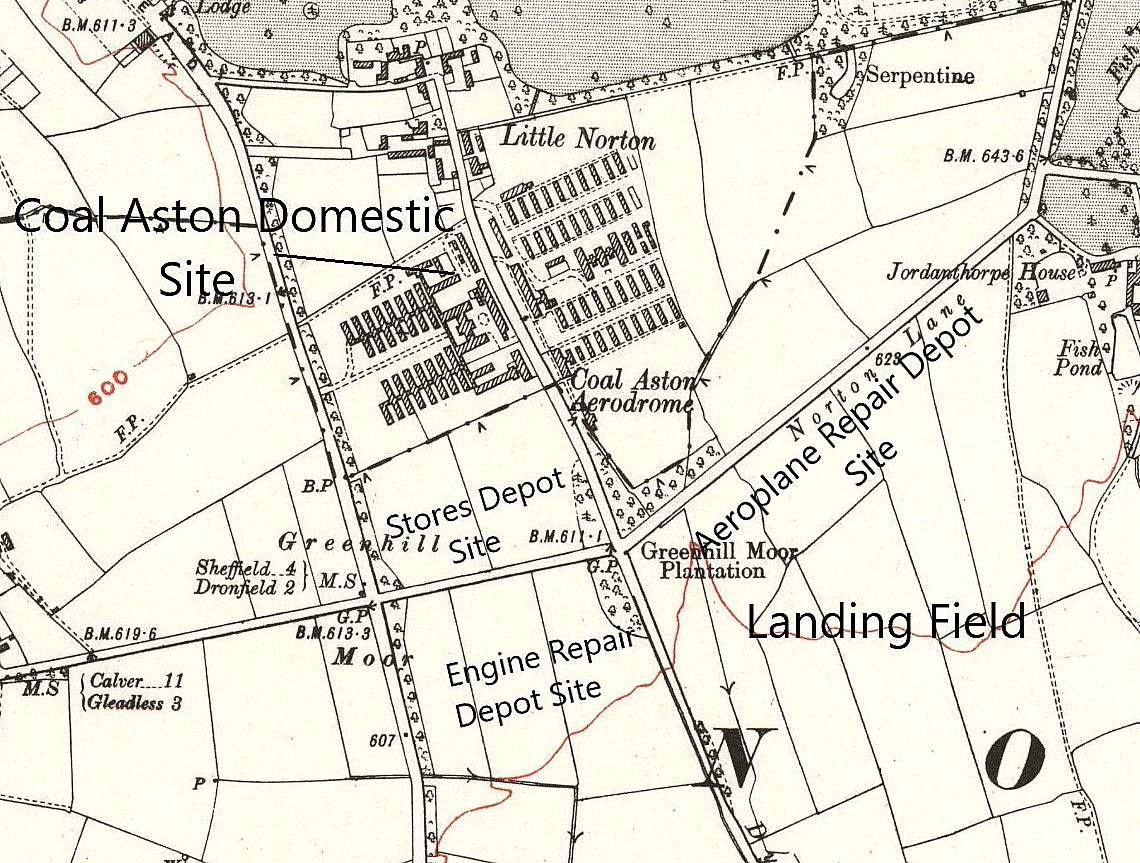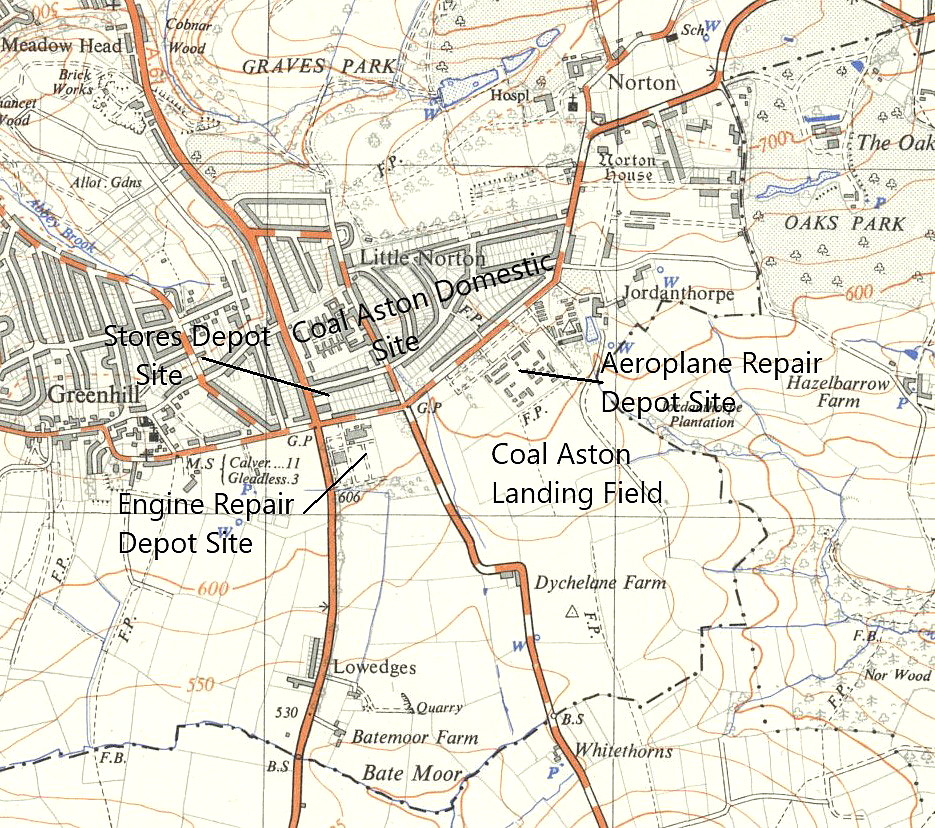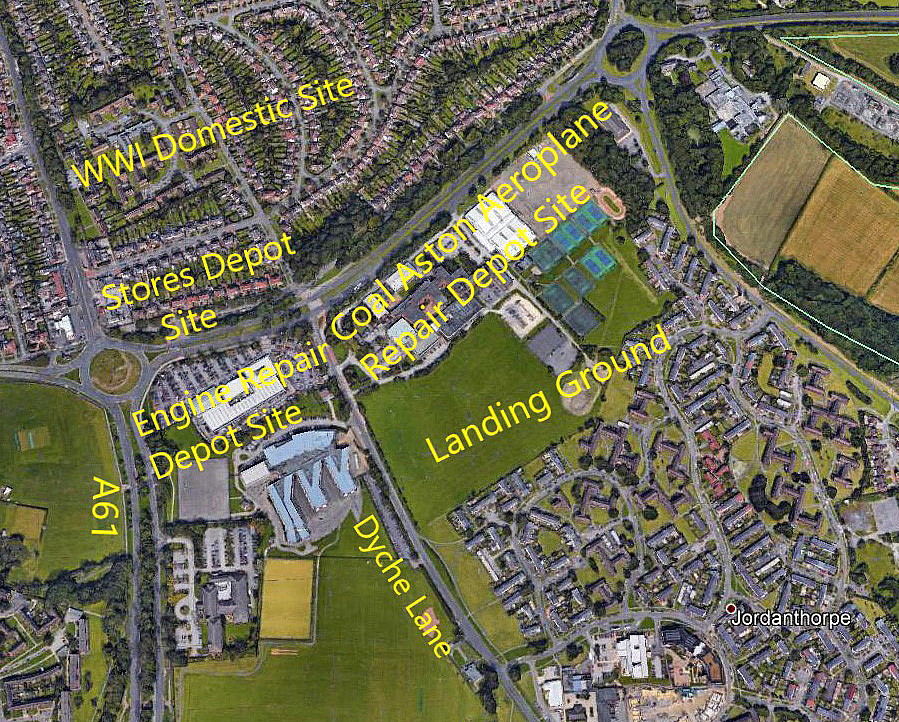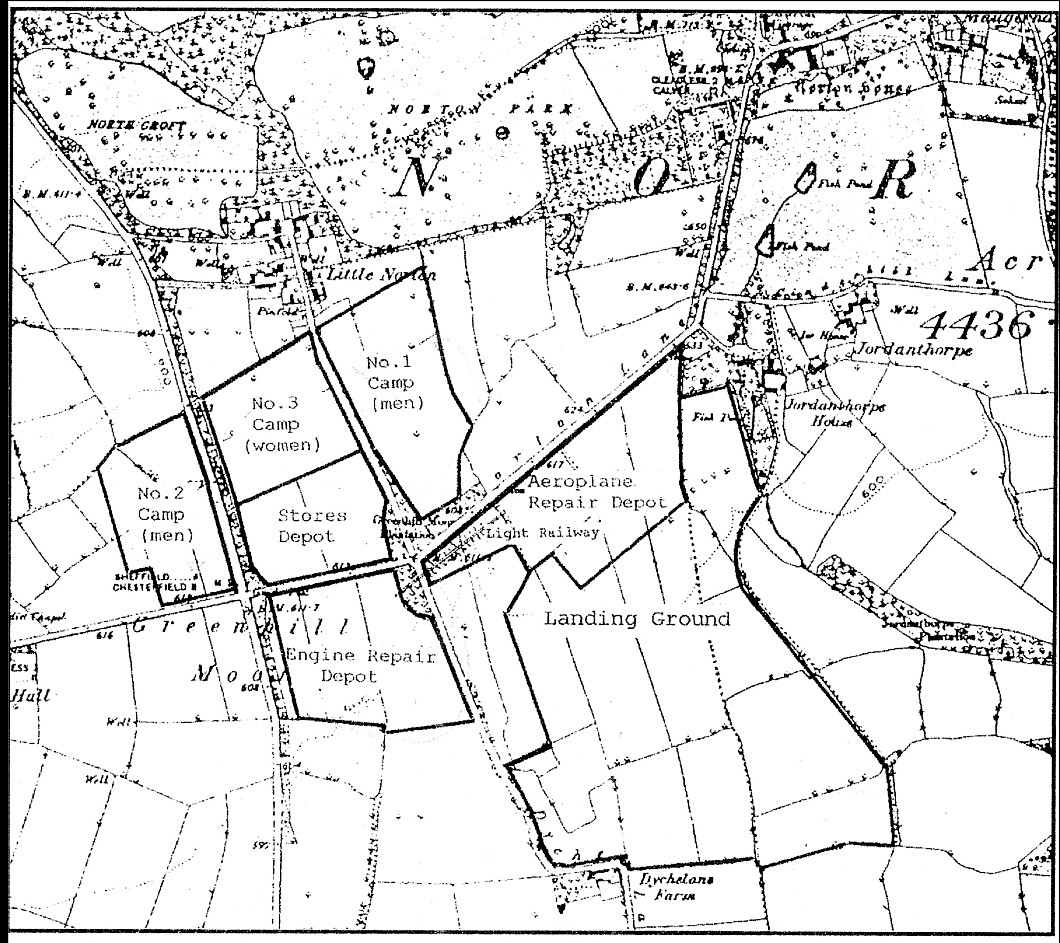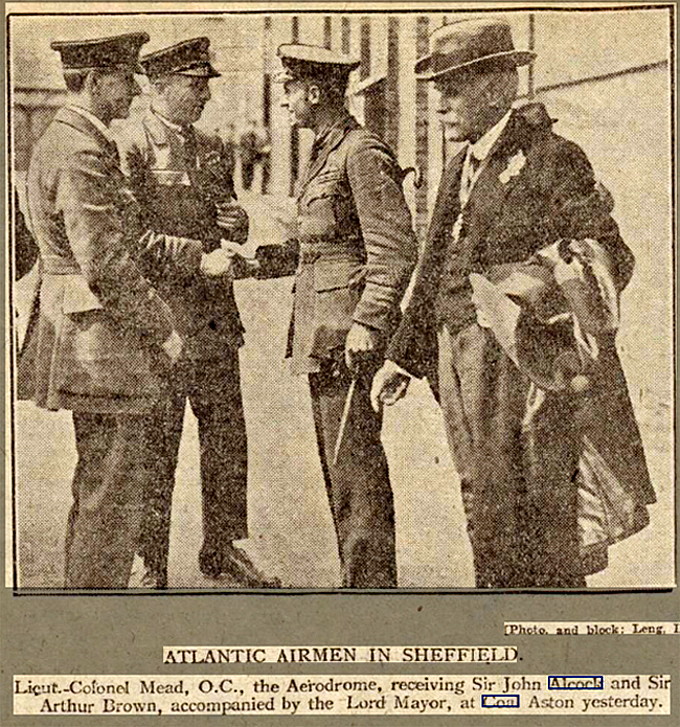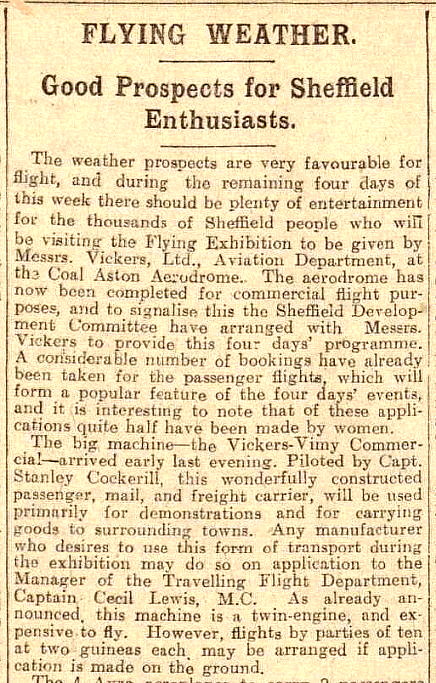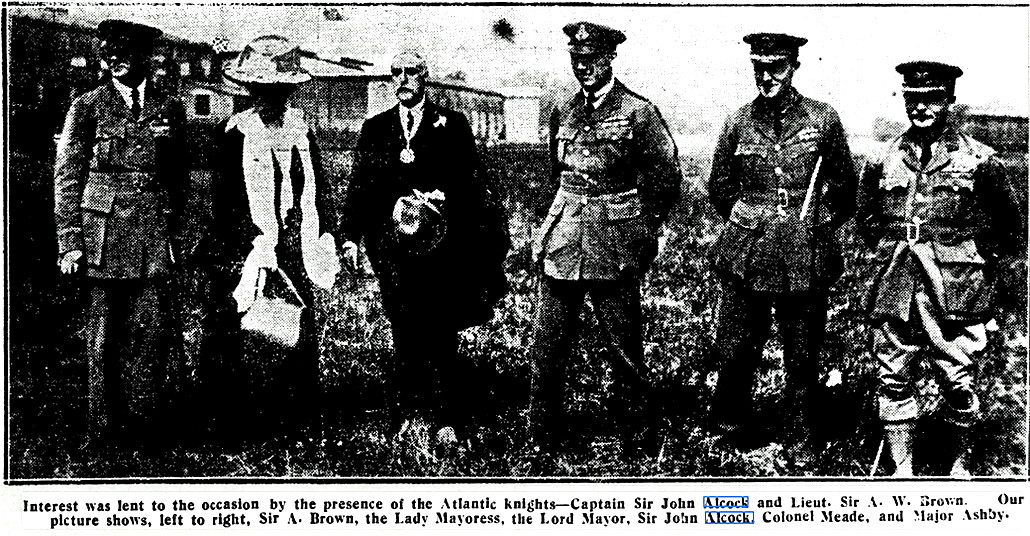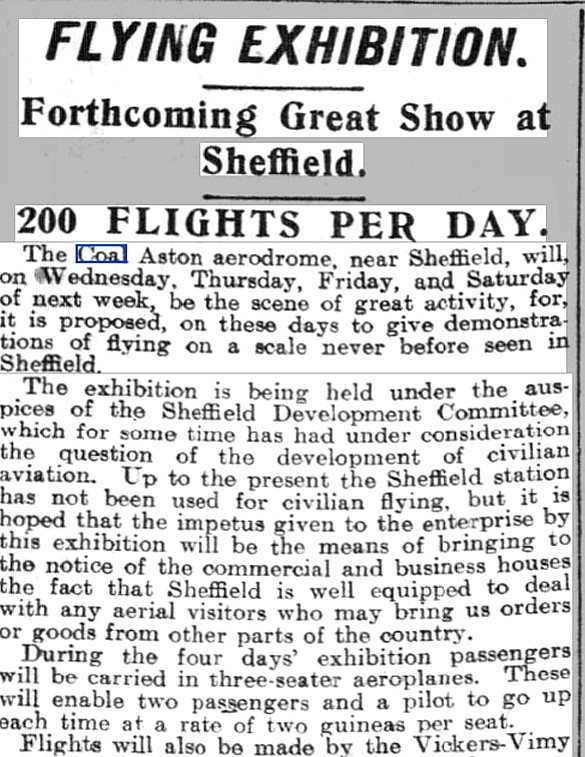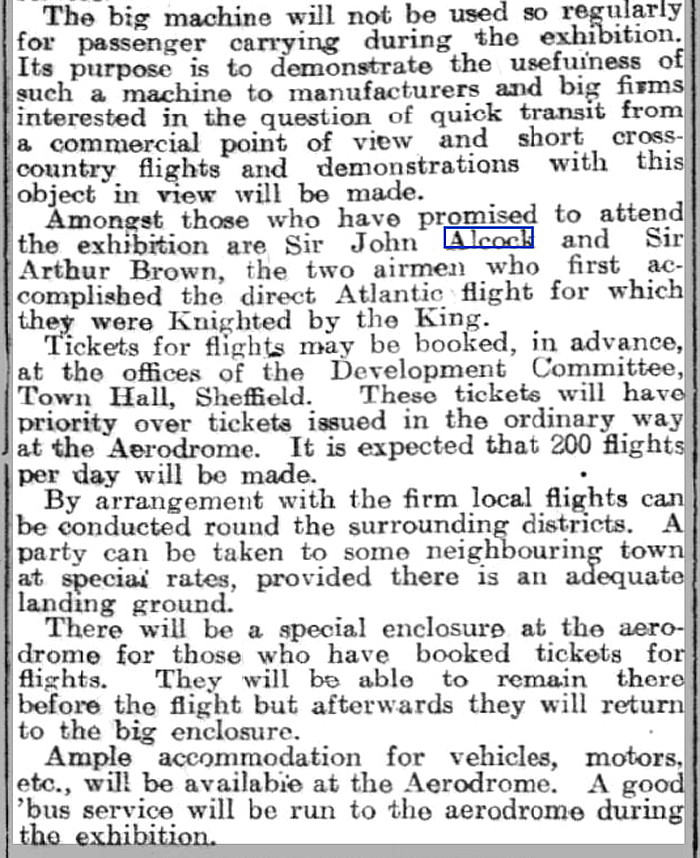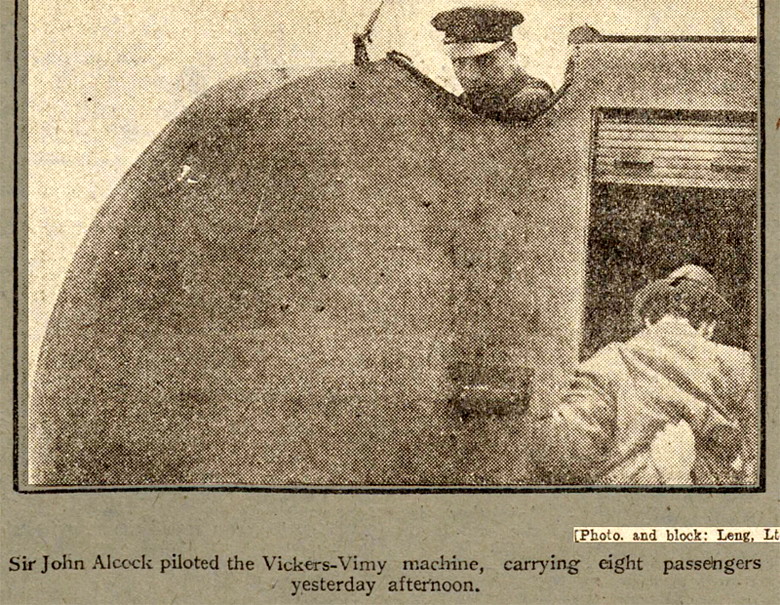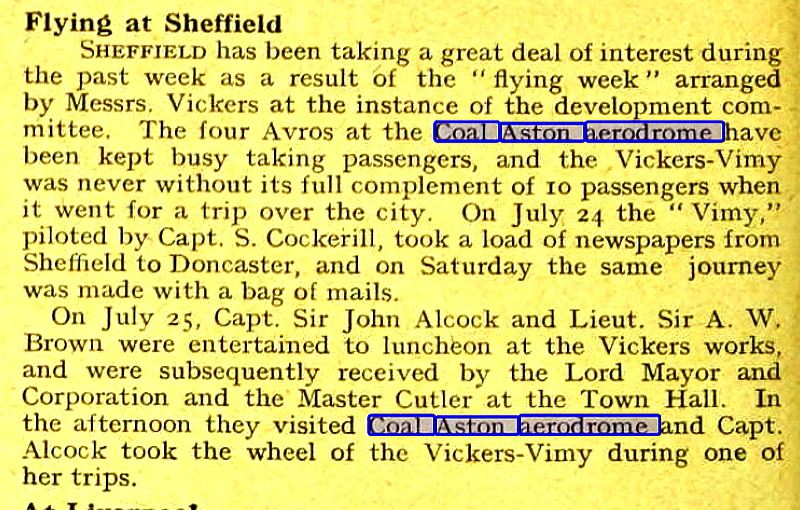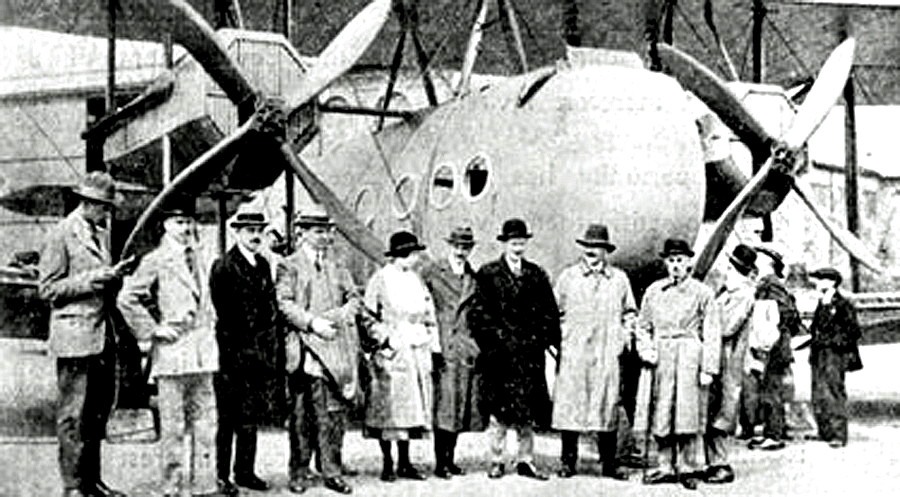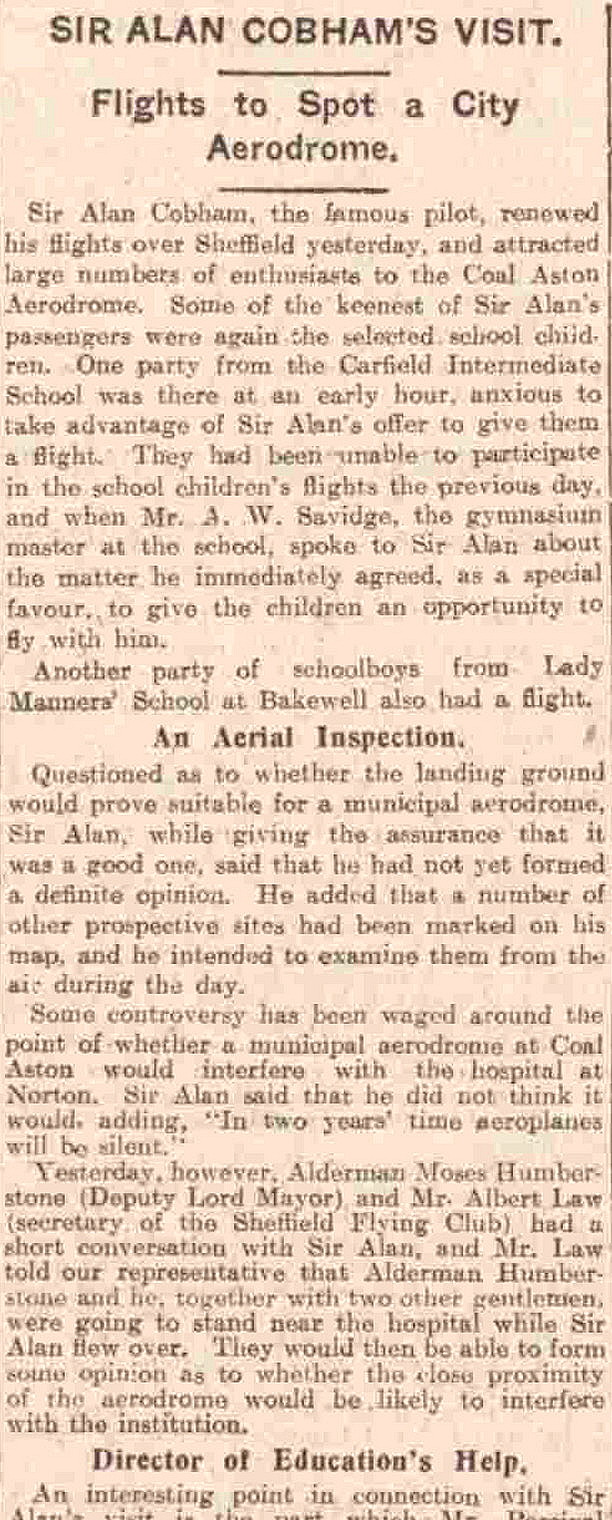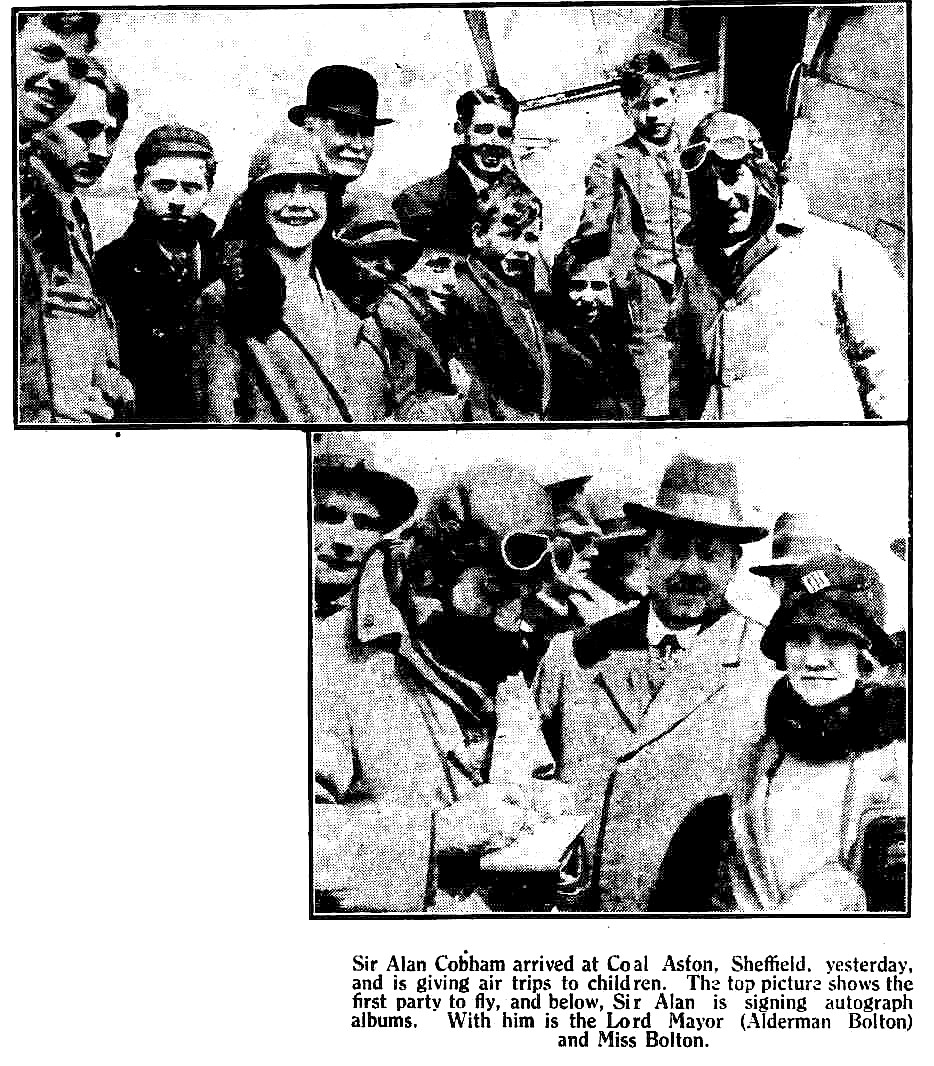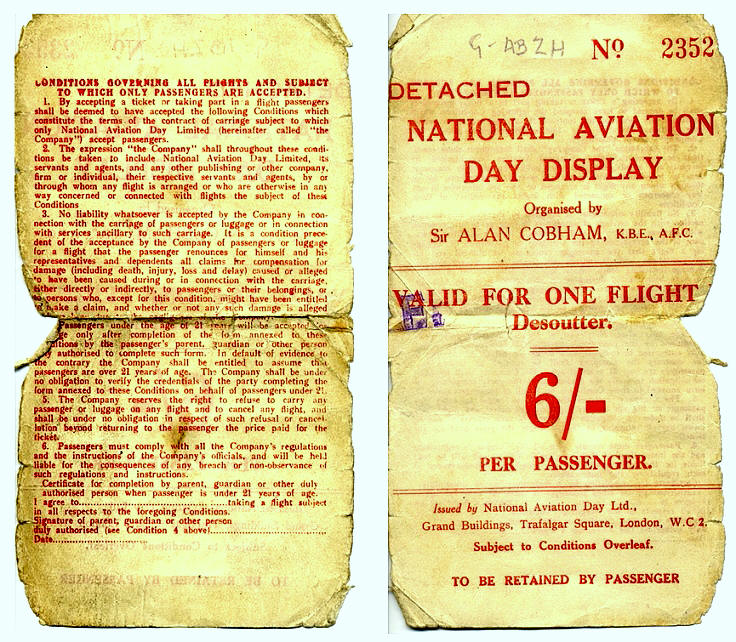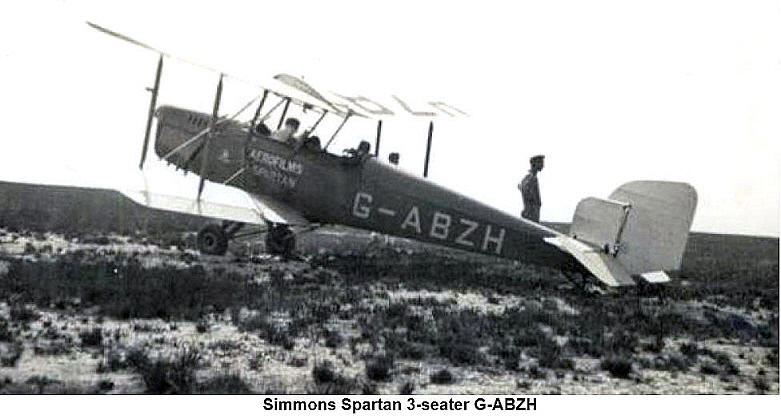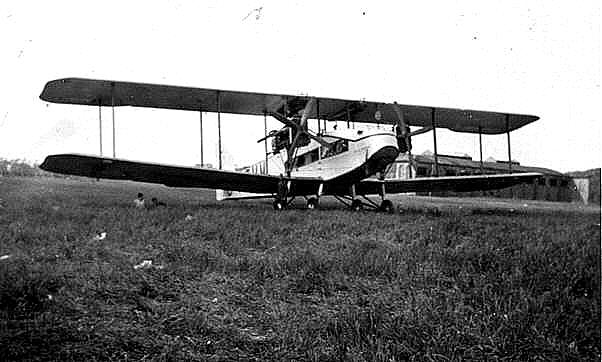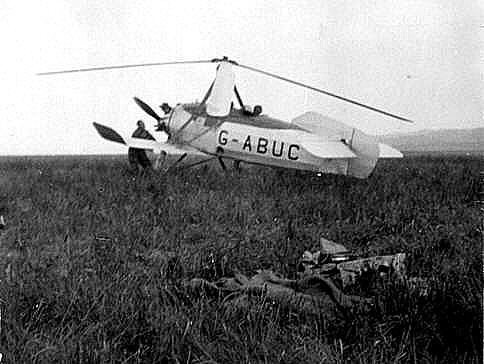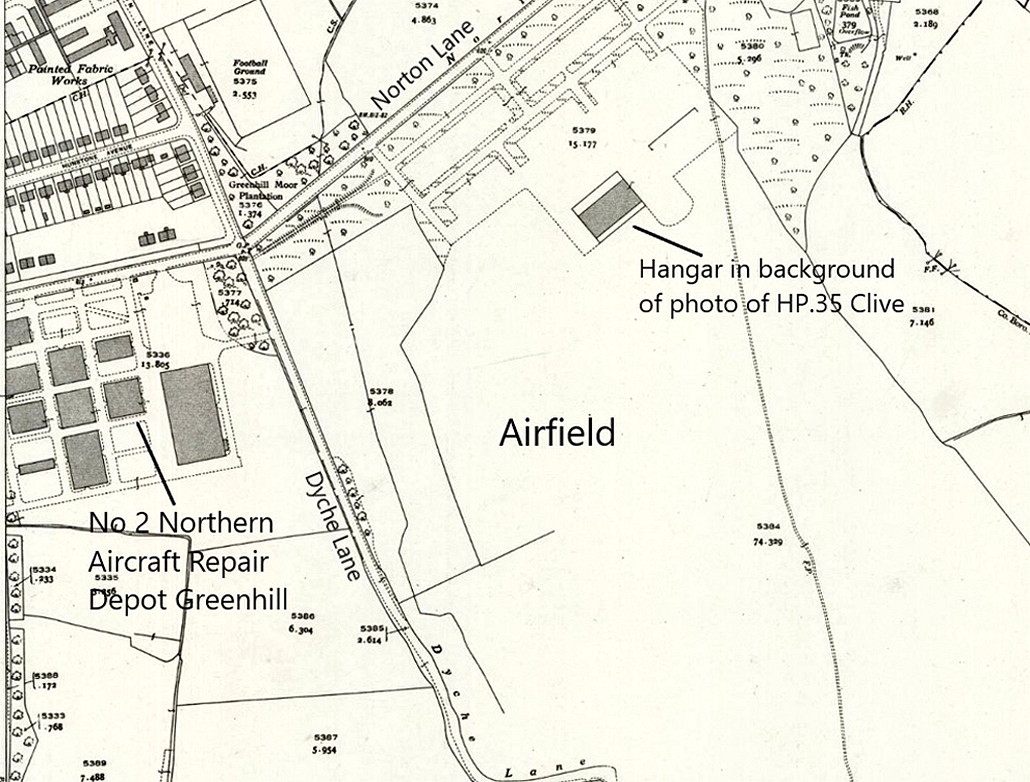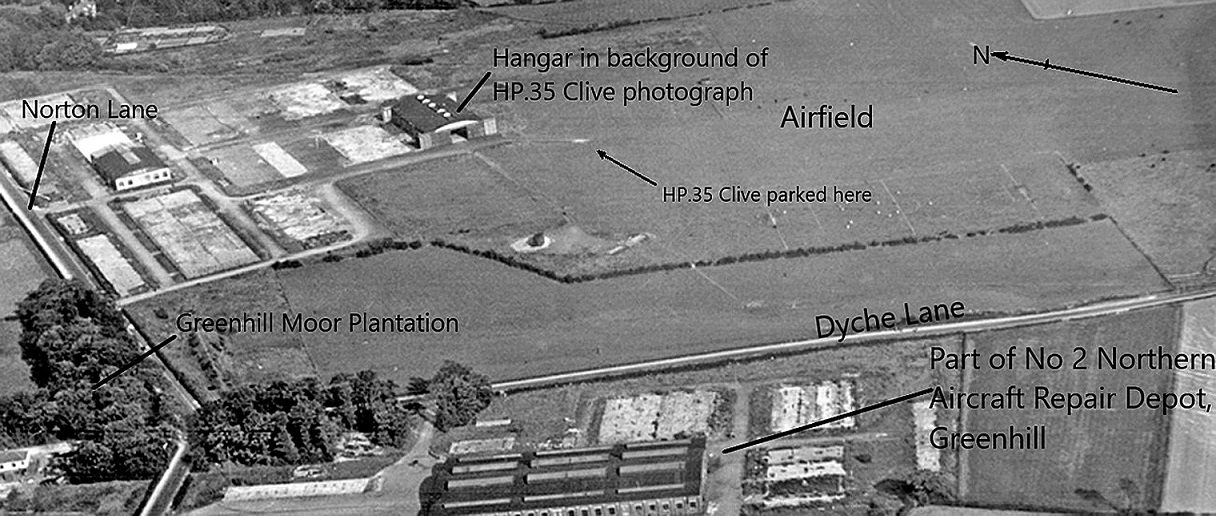Coal Aston, Yorkshire
COAL ASTON: Military aerodrome later civil Landing Ground
A QUERY
Note: These two maps and Google picture were kindly provided by Mr Michael T Holder
The query arises regarding whether or not the Ordnance Survey map is correct? Was there really an 'aerodrome' here? The obvious answer is no - it is far too small, even in those early WW1 days - for an aerodrome as such. However, given the short take-off run needed for most types in WW1, especially when lightly laden, it is entirely feasible that some aircraft may have been assembled for delivery to RFC aerodromes in the region? If anybody can kindly offer advice, this will be much appreciated.
THE LARGER AND MAIN SITE
Note: These maps and pictures were also kindly provided by Mr Michael T Holder. The aerial photo Mike has found, appears to have been taken in a snow shower?
Military users: WW1: RFC (Royal Flying Corps) Home Defence Flight Station and Landing Ground
1915 to ? RFC No.17 Training Squadron (Royal Aircraft Factory BE2c)
It appears that detached Flights from 33 Squadron, based at GAINSBOROUGH, also operated from here. Their main task being to defend Sheffield from bombing raids by German airships. Most, but not all, built by Zeppelin.
RFC/RAF No.2 (Northern) Aircraft Repair Depot and Engine Repair Depot
A BONUS PICTURE
Note: Mike Holder, who is a great friend of this 'Guide', also unearthed this map of the WW1 establishment. And indeed, the items shown below:
A NOTABLE AIR DISPLAY
In July 1919 the Sheffield Development Committee held a four day Air Display, from the 22nd to the 25th. Two notable celebrities turned up for the event, Sir John Alcock and Sir Arthur Brown, recently knighted after making the first west-east crossing of the Atlantic on the 14th June.
The first and third pictures were published in the Sheffield Independent on the 26th July. The newspaper article was published in the Sheffield Daily Telegraph on the 23rd July.
Shown in three parts, to make it easier to read, this article was published in advance on the 16th July in the Sheffield Evening Telegraph.
The article was published in The Aeroplane on the 31st July 1919.
The Vickers Vimy Commercial, seen here, was an airliner version of the famous WW1 bomber, and was I believe, the only example on the UK register. It was first given the interim registration K-107, and was soon to become G-EAAV, one of the very first batch of aircraft to be given the new British 'G-' registration marks - denoting a British civilian aircraft. Starting with G-EAAA in May 1919, this example was registered on the 13th May. Being the prototype it made its first flight from JOYCE GREEN (KENT) on the 13th April 1919 and was, it appears, the last Vickers type to have made its first flight from this aerodrome.
Operated by: 1919 until the 30s: The Sheffield Corporation
Location: Roughly 5nm S to SSE of Sheffield city centre, in WW1 said to be 2 miles from Beauchief railway station, presumably ESE of this station. Later information from Ron Smith in his book British Built Aircraft Vol.5 says it was “located to the east of the Chesterfield Road and Dyche Lane, and to the south of the Greenhill to Jordanthorpe road”.
Note: As you will see from the maps above, the 'aerodrome' was once marked as being on the north side of the Greenhill to Jordanthorpe road.
Period of operation: Military: 1915 to 1920 Civil: January 1921 to July1932
Site area: WW1: 206 acres 1646 x 549
Runway: 1933: Max landing run: 411 grass
NOTES: Listed as being in the WEST RIDING of YORKSHIRE, (now SOUTH YORKSHIRE), when operational during and just after WW1
It appears the No.2 (Northern) Aircraft Repair Depot was second only to FARNBOROUGH in the UK with reservations for about 500 aircraft including FK.8, RE8, FE2B and BE2E types. But, Ron Smith reckons they actually handled the Armstrong Whitworth FK.8, Sopwith 1½ Strutter and Sopwith Pup. He makes a quite exact description of the site stating; “Facilities included two flight sheds, three erecting shops and one dismantling shop together with sundry machine shops, test buildings and stores. Accommodation was provided in two camps to the north of the site, one of these being for German Prisoners of War.”
He then goes on to say in 2004/5, “The flying field to the south of these sheds remains open space in use as playing fields.” There were of course two other major Aircraft Repair Depots in France, at St Omer and Candas, plus several other smaller facilities.
Note: These relate to the visit made by Sir Alan Cobham in May 1929. (See below). The article is from the Sheffield Daily Telegraph published on the 31st May, and the pictures are from the Sheffield Independent published on the 30th May. Both were kindly provided by Mr Michael T Holder.
A VISIT BY SIR ALAN COBHAM
On the 29th and 30th May 1929, Sir Alan Cobham made a two day visit during his Municipal Aerodrome Campaign. The original plan was to visit 107 venues, but he eventually managed about 95. This being a quite remarkable achievement in itself.
The aircraft he used most of the time, (he had two quite serious crashes), was the ten-seater de Havilland DH61 'Giant Moth' G-AAEV, named 'Youth of Britain'. At each venue he would typically take the local dignitaries for a flight around the local area, extoll the virtues of having a municipal aerodrome/regional airport, then take around forty or fifty selected schoolchildren for flights. These flights being paid for by an anonymous donor, who we now know was Lord Wakefield of Castrol Oil fame. The would then take up fare paying passengers flying, normally until dusk. The purpose of these being, presumably, to help cover the costs of the Tour.
FLYING CIRCUS VENUES
Berkshire Aviation ‘Flying circus’ venue 1921.
1932 venue: 8th & 9th July, then a second visit on the 8th October 1932, for Alan Cobham’s 1932 National Aviation Day UK Display Tour.
1933 venues: 3rd June & 5th June 1933 ,- (they flew to display at Nottingham on the 4th) for the 1933 No.1 Tour. On the 16th September 1933 Cobham’s No.2 Tour paid a visit, so it appears this was regarded as a successful venue.
1934 venue: Once again on 24th May 1934 Cobham’s 1934 Tour of the UK paid yet another visit.
1935 venue: Finally, on the 12th September Cobham’s No.1 tour performed here.
A.A. LANDING GROUND
In the 1930s this was one of seventy-four A.A. (Automobile Association) approved Landing Grounds on mainland Britain. Fuel and a telephone was available from the “Aerodrome Garage.” Transport, (typically a taxi service), was available from Kenning’s Garage and Newboults & Sons. The recommended hotels were the Grand, Leopold Street or the Royal Victoria Station. The Grand hotel, the “finest hotel in Sheffield” was demolished in 1973 to make way for the ‘Fountain Precinct’. The Royal Victoria Station hotel appears to be a Holiday Inn these days? Perhaps oddly though, considering its major status in WW1, it appears that only one hangar remained on this site in 1933.
A GREAT CONTRIBUTION
In November 2022 I was kindly contacted by Mr David Jessop who has provided these very rare pictures, the three photographs being taken on the day, the 5th June 1933 by his father. Items such as these are very much appreciated, not least because of their rarity, and I never thought, even for one minute, that a used ticket would come along. I have never seen another example.
NOTES: The ticket shows that it was valid for a flight in a Desoutter, a cabin aircraft. Records show that Cobham's 1932 tour included a Desoutter, G-AANE, but not the 1933 or subsequent tours. (An early example of re-cycling?). However, the ticket shows it is marked G-ABZH, and that was a Spartan Three Seater II, (see second picture). Operated by Aerofilms based at HESTON, it had a very short life. First registered 04.10.32, it was registered to Aerofilms from 19.01.33 to 02.10.33 when it was pronounced WFU (Withdrawn From Use). This being because it suffered a very serious crash at Colpe Farm near Drogheda in County Louth, during one of Cobham's displays on the 1st October 1933. The pilot was killed but the two passengers survived.
Third picture: The Handley Page HP.35 Clive, G-ABYX, was operated by Sir Alan Cobham's National Aviation Day company in the 1932 and 1933 Tours. Re-registered to Sir Alan Cobham's National Aviation Displays Ltd, it took place in the 1934 and 1935 Tours. Or so it seems, another record states it was scrapped in 1933!
Fourth picture: The Cierva C.19/IVP Autogiro, G-ABUC, was it appears, built by Avro as a type 620. Registered to SIr Alan Cobham's National Aviation Day Ltd in 1933, and Sir Alan Cobham's National Aviation Displays Ltd in 1934. it is not listed in the 1935 Tours. It was sold to Singapore in November 1936 as VR-SAR.
AN INSPIRATION
Delighted to see the contribution by David Jessop, (above), Mike Holder went off on a delve and came up with these three items:
Note: Both of the aerial photographs were obtained from the Sheffield City archives.
ian kingsnorth
This comment was written on: 2016-02-07 16:31:36Nice article found it during research for exhibition at South Yorkshire Aircraft Museum in Doncaster about Zepplin raids on Sheffield in 1916. Will open exhibition in September 2016. Have amassed quite alot of plans and photos of site in WW1 and after including the Alan Cobham visits with large Handley Page W9 airliner for joy rides.
Reply from Dick Flute:
Hi Ian, Many thanks for your kind comments. The exhibition sounds very interesting, but, being London based and so much going on, I cannot be sure if I can pay a visit. Being a tad cheeky, would it be possible to scan a couple of images to illustrate my listing with? As you can see I have nothing so far. By e-mail address is on the front page. Best regards, Dick
We'd love to hear from you, so please scroll down to leave a comment!
Leave a comment ...
Copyright (c) UK Airfield Guide














